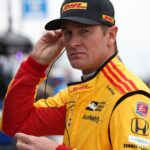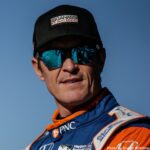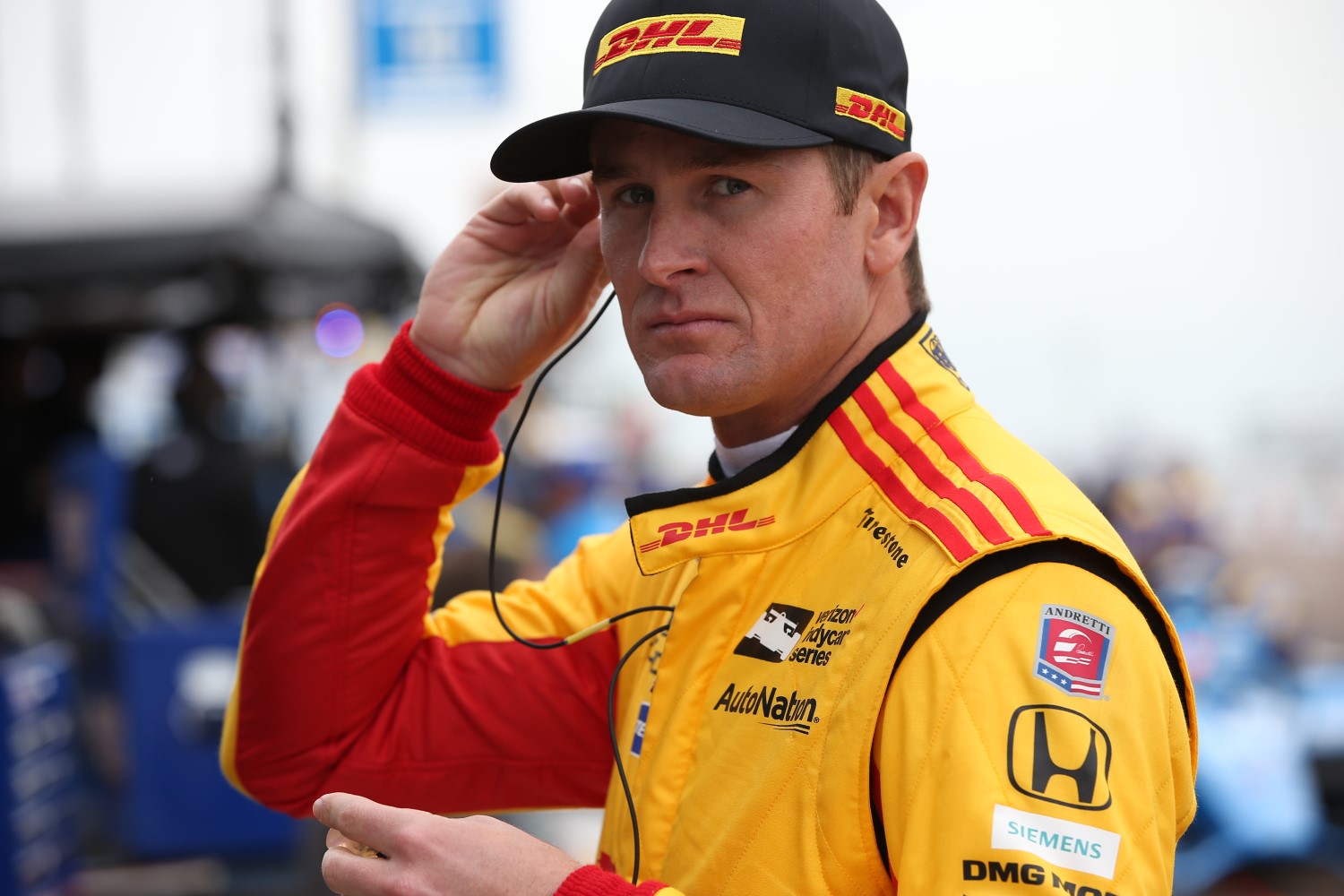IndyCar Long Beach Friday Press Conference
 |
| Ryan Hunter-Reay |
Drivers
Scott Dixon
Ryan Hunter-Reay
Press Conference
THE MODERATOR: We will get started with our Verizon IndyCar Series post-practice press conference. Pleased to be joined by the fastest two drivers of the combined time sheets from practice 1 and practice 2, Scott Dixon, driving the No. 1 PNC Bank Chip Ganassi Racing Honda for Chip Ganassi Racing, and Ryan Hunter-Reay, driving the No. 28 DHL Honda for Andretti Autosport. Scott, fastest in the combined sessions today, also a former race winner here at the Toyota Grand Prix of Long Beach in 2015. Take us through your day and the track condition.
SCOTT DIXON: Yeah, the PNC Bank car felt great this morning. I think in the cooler conditions the car was just ideal. It was one of those mornings where we really didn't have to change too much. It rolled off the truck really fast and was consistent throughout the session on the one set of tires. This afternoon was definitely a bit of a different story, really struggled with front grip. It seemed like the temperature really affected our car. There was a couple others that went quite fast in that session on the red tires, and I actually had to do almost a long run on my reds to get them to work. I think I did my quickest time on lap 7 or 8. It was kind of an interesting session for us, but I think the car is kind of there, it's just going to take a little bit to get it right, and obviously tomorrow come qualifying is going to be tough as always for the Firestone Fast Six.
THE MODERATOR: Speaking of qualifying, joined by a former pole winner of the Toyota Grand Prix of Long Beach, Ryan Hunter-Reay, who won pole in 2014 but also a former race winner here in 2010, and Ryan, you've had a lot of opportunities, you've led a lot of laps here, a lot of opportunities to win this race for a second time. What are your thoughts on this track? It's obviously one that I think means a lot to you personally but also one that you've performed very well on throughout the past several years.
RYAN HUNTER-REAY: Yeah, without a doubt one of my favorite races. Love the place, love the layout, love everything about it, the fans, the energy, the atmosphere here. But we've had some great cars here, very fortunate to have been behind the wheel of some very fast race cars here, last year being one of them. And just in the closing laps, closing on Hinch there right up on his gearbox and the car shut off for some reason, electrical something or other, so we feel like we have some unfinished business here. We feel like today was a pretty good start to that.
We're going to need to find that gap was Scott was referring to between the cooler track temps and when it heated up. It became quite a bit more difficult to get the lap time out of the car. Kind of a bit of a challenge there. It seems like everybody has their work set out for them. Yeah, we'll see. We'll put our heads together tonight, hopefully come out tomorrow and be stronger.
Q. I think tomorrow before the qualifying you have the IMSA race, different rubber; are you concerned about that and how it's going to affect your qualifying tomorrow?
SCOTT DIXON: Well, it's the same for everybody. You just, I guess, hope that you hit it the right way. I think — did we follow them this morning maybe or close to —
RYAN HUNTER-REAY: Close to it, yeah.
SCOTT DIXON: So it's always tough to figure out. I think the ambient conditions probably play a little bit more havoc, but you're right, it could be totally different, especially after a two-hour race. That's a lot of Continental and Michelin rubber that's going on. I know even driving the Ford GT, the Continental tire, the rubber messes a lot with the Michelin.
[adinserter name="GOOGLE AD"]Q. The new body work is a reduction in downforce, and I know today was only practice. Has it encouraged you to be a little bit more bold around this track?
RYAN HUNTER-REAY: Bold, probably not. You're not able to get away with quite as much. The car is more on top of the racetrack, moving around. You're constantly catching it. You can feel it's lighter in the brake zones, especially when you're coming off modulating out of the brake pedal coming into the corner, you can feel you just have a little bit less of an elbow to lean on through the corner. It's just a bit more lively.
It's fun, we love it. It just takes a bit of an offset kind of in your approach, and like Scott mentioned, it's the same for everybody, so it's a good thing.
Q. Just get y'all's thoughts on maybe the tire degradation and maybe where that cliff is that we might see on Sunday, and just what is the comparison there for the preferred tire to be on come race day?
RYAN HUNTER-REAY: Do you want to go ahead and disclose your tire strategy now?
SCOTT DIXON: All blacks.
RYAN HUNTER-REAY: I like that one.
SCOTT DIXON: It's hard to tell. You know, I think if you go off previous history, then it's a pretty easy decision. But we'll have to see how that — the track temp, at least for our car, seems to play havoc a lot more than the actual tire, and the rate is pretty durable it seems. We just did a fairly long run on it, and it seems pretty good, it just maybe is better overall. I think most of the time you just look at trends, and that tells a pretty good picture.
RYAN HUNTER-REAY: I think everybody was a bit surprised the red wasn't faster today, so there's some questions, I think, hanging over everyone's heads now about what the potential there is and where the long-term life is with that tire.
Q. We heard some of the veteran drivers at St. Pete saying it was kind of hard to kick the old habit with the last car with the more downforce. Have you started to feel like it's second nature now, or is the learning curve, are you still in the process of that?
RYAN HUNTER-REAY: I think everywhere you go it's a challenge. Every racetrack we show up at, we don't know what the offset is going to be to our setup that worked the previous year and what challenges we're going to have. Like when we came here, are we going to be braking a full brake marker sooner. There's just always obvious challenges there.
SCOTT DIXON: Yeah, I think a lot of it depends on how you roll off. Your weekends, there's such a limited amount of track time really and tires, so that can affect it a lot. No, I don't think you get stuck in your ways. I think every year the cars is evolving somehow, whether it's the tire or the aero kit that we've had. This has been our biggest reduction in a long time, but I don't know, veterans are getting labeled with a lot of things lately.
Q. There's been a couple drivers to mentioned their braking zones today. Why was that — is it because of the longer straights here? Why wasn't that a lesson learned at St. Petersburg?
SCOTT DIXON: I didn't find it much of an issue this morning, but then today and this afternoon with the track temp for us, for some reason, the brake zones were different and a lot trickier. I think I went off in 1 and then also went off in 8. 8 was actually on an outlet, I just went a little too deep, and then instead of locking the tire decided to go straight ahead. But you are approaching it at a pretty high rate of speed, and I also think the wind direction can mess you up pretty good here, so that turned pretty heavily in another direction during the session today.
RYAN HUNTER-REAY: I think St. Pete was a hint at what was coming, but some of the tracks we go to, we're not braking that much earlier, so it surprises you in some places how deep you can brake despite the higher top speed and less downforce on the braking.
Q. Ryan, you mentioned that you feel like you have some unfinished business here. Last year and the mechanical problems last year that you mentioned were electrical, does that interact in any way with the new aero kit, and also were those problems track specific or was it just random?
RYAN HUNTER-REAY: No, we seem to pick up the random electrical stuff. We're pretty good at that. The car shut off on us at Pocono while leading in 2016 or 2017, same problem that shut off here, and then we had the car do something weird before the race at St. Pete. We started from the pit lane in St. Pete, too, which was a completely different electrical issue. I don't know, we seem to experience a lot of them, and every one of them seems to be different, and there's no clear solution.
I think after the failure here last year, the electrical failure that we had in the race, there was a new operating procedure that was enlisted to the whole series, and things changed for everyone with that PDU. So I'm not sure, but good came from it, I guess.
 |
| Scott Dixon |
Q. Last week's finish notwithstanding, when you went from 17th all the way up to fourth, this is your 18th year in IndyCar racing, and I would say 15 of those seasons you're a bit of a slow starter. Have you ever figured out why that is?
SCOTT DIXON: It's more fun that way, right? No, I don't know. You know, recently I think in the last few years we've had some really strong starts and then had some pretty big hits later on in the season. Yeah, you know, I think St. Pete the car was really fast. To have a couple penalties and a drive through and still get up to sixth, I think we did a good job there. And Phoenix we just really missed the boat. Thankfully strategy wise and the cars in the pits made an amazing race for us or comeback at least for points, so it was a good salvage. But yeah, we've got to be trying to race for wins here right now.
Q. You guys are both Honda drivers; Honda has done well all three races so far this year, right? They won out of the pole in St. Pete, sat on the pole in Phoenix, Rossi was quick in Phoenix in a Honda, and you guys were quick today. Do you feel the Honda power has anything on the Chevys this year?
SIMON PAGENAUD: I think both manufacturers are pretty even. I think they have their strengths in different areas. I know this is a big weekend for Honda, right. I think they've got the global CEO coming here celebrating the 25th year of HPD, so they obviously want to win this race, and we'll be trying to — we want to win every race. But yeah, I think Honda have done a very good job on the engines, and it's good to see. I think once we get to some more of the flat-out tracks, we'll get to see where that lays. But maybe driving — I don't know, they're just two very different to drive. I've kind of done both of them in the last three or four years, and different mindsets, but I think Honda and HPD are doing a very good job.
RYAN HUNTER-REAY: Yeah, I agree Honda and HPD are doing a great job, and I don't feel like Honda or HPD is behind at all. I think it's a pretty even match-up on road and street courses, but like Scott said, we're all pretty eager to see where we stand when we do the open test at IMS. That will, I think, give us a better picture of where we are.
